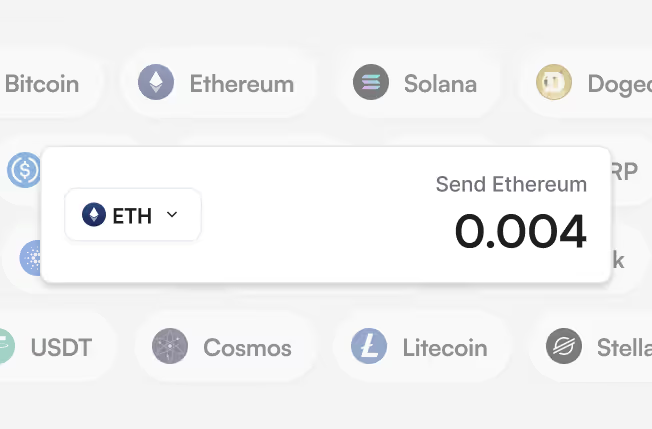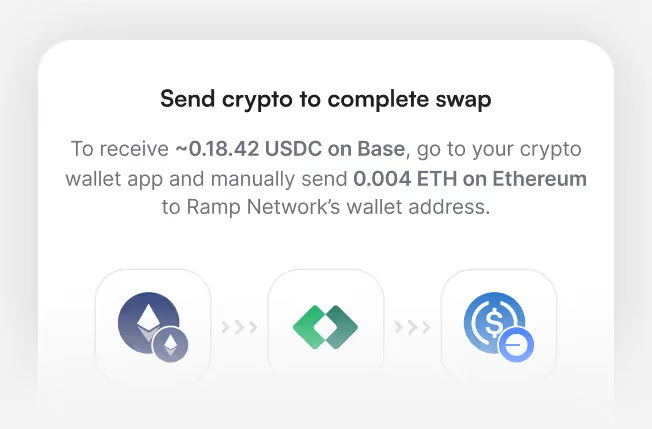


Swap Tether to Ethereum seamlessly.
Covert Tether (USDT) to Ethereum (ETH) quickly and securely with Ramp Network – no complex bridges or exchanges needed.


.svg)










Covert Tether (USDT) to Ethereum (ETH) quickly and securely with Ramp Network – no complex bridges or exchanges needed.


.svg)







Swapping Tether (USDT) for Ethereum (ETH) with Ramp Network is quick, secure, and built for simplicity.

1
Choose Tether (USDT) and Ethereum (ETH), enter how much you want to swap, and check the live exchange rate before proceeding.

2
Register using your preferred sign-up method and confirm your country of residence to continue.

3
Ramp Network supports both self-custodial wallets like Ledger or MetaMask and custodial exchange accounts. You remain in full control of your assets throughout the swap.

4
Transfer the USDT from your wallet. Once confirmed on the blockchain, ETH is delivered directly to your chosen wallet or exchange account.

Ramp Network supports both self-custodial wallets such as Ledger or MetaMask and custodial exchange accounts. When swapping USDT for ETH, you simply connect your wallet, review the details, and confirm the exchange.






The swap flow is built to stay intuitive and easy to follow. Ramp Network avoids unnecessary crypto jargon, making USDT-to-ETH swaps accessible even for beginners.
You remain in full control of your funds. USDT is transferred directly from your wallet, and ETH is delivered to your chosen wallet or exchange account. Ramp Network does not retain user assets beyond the swap process.
Ramp Network operates across major regions, including the UK, EU, and US. Supported networks and assets are displayed clearly during checkout.

Before completing your USDT-to-ETH swap, you’ll see a detailed overview of all information, including live rates and applicable fees, so you know exactly what to expect.
*When compared to transferring via an exchange

Tether, better known by its ticker USDT, is the digital world’s version of the U.S. dollar. It’s what people call a stablecoin – a token that’s meant to hold its value rather than fluctuate like most cryptocurrencies. Each USDT is designed to be backed by real-world assets such as cash or short-term treasuries, so one token should always equal about one dollar.
It first appeared back in 2014, long before “stablecoin” became a buzzword. Traders started using it to move dollars across blockchains in minutes instead of waiting days for a bank wire. Since then, it’s become part of crypto’s everyday toolkit – used for remittances, DeFi lending, and even payments for freelancers around the world.
You’ll find Tether running on many networks – Ethereum, Tron, Solana, and others, which helps keep transactions fast and affordable. It isn’t meant for speculation or hype; it’s meant for utility. For most people, USDT is simply a reliable, digital stand-in for traditional money.
Bitcoin (BTC) is the world’s first cryptocurrency, launched in 2009 by the mysterious creator known as Satoshi Nakamoto. Built on blockchain technology, Bitcoin introduced a new way of transferring value online without the need for banks or intermediaries. Its decentralized nature, combined with a fixed supply of 21 million coins, makes it a unique digital asset often referred to as “digital gold.”
Today, Bitcoin is the most recognized and widely used cryptocurrency worldwide. Millions of people use it for trading, investing, and cross-border payments, while businesses across industries accept Bitcoin payments as a secure and transparent alternative to traditional money. Its popularity continues to grow, supported by increasing adoption from financial institutions, mainstream investors, and even governments exploring Bitcoin regulation.
What makes Bitcoin special is its combination of scarcity, security, and decentralization. Unlike fiat currencies that can be printed endlessly, Bitcoin’s supply is limited, creating long-term value potential. Its blockchain is maintained by thousands of nodes across the globe, ensuring transactions remain transparent and resistant to censorship. For many users, Bitcoin represents more than just an investment — it’s a revolutionary step toward financial freedom and the future of money.
The chart displays an indicative, mid-market exchange rate. Effective exchange rate might be different.

Ethereum launched in 2015 as a blockchain designed not only for payments but also for running smart contracts – programs that execute automatically when conditions are met. This approach opened the door for decentralized applications.
Over time, Ethereum has become one of the most widely adopted networks in the crypto space. Developers use it for decentralized finance (DeFi), non-fungible tokens (NFTs), stablecoins, and many other blockchain-based tools.
Ethereum is maintained by a global community and continues to evolve through network upgrades aimed at improving scalability and efficiency. These updates, such as the transition to proof-of-stake, are designed to make the system more energy-efficient and adaptable for future applications.
ETH, the network’s native token, is used to pay transaction fees and secure the blockchain through staking. It also underpins governance decisions in many protocols built on top of Ethereum. Selling ETH is a straightforward way to exchange digital assets for local currency once you no longer wish to hold them.
Bitcoin (BTC) is the world’s first cryptocurrency, launched in 2009 by the mysterious creator known as Satoshi Nakamoto. Built on blockchain technology, Bitcoin introduced a new way of transferring value online without the need for banks or intermediaries. Its decentralized nature, combined with a fixed supply of 21 million coins, makes it a unique digital asset often referred to as “digital gold.”
Today, Bitcoin is the most recognized and widely used cryptocurrency worldwide. Millions of people use it for trading, investing, and cross-border payments, while businesses across industries accept Bitcoin payments as a secure and transparent alternative to traditional money. Its popularity continues to grow, supported by increasing adoption from financial institutions, mainstream investors, and even governments exploring Bitcoin regulation.
What makes Bitcoin special is its combination of scarcity, security, and decentralization. Unlike fiat currencies that can be printed endlessly, Bitcoin’s supply is limited, creating long-term value potential. Its blockchain is maintained by thousands of nodes across the globe, ensuring transactions remain transparent and resistant to censorship. For many users, Bitcoin represents more than just an investment — it’s a revolutionary step toward financial freedom and the future of money.
The chart displays an indicative, mid-market exchange rate. Effective exchange rate might be different.
Customers like you have traded over $1 billion in crypto with Ramp Network.